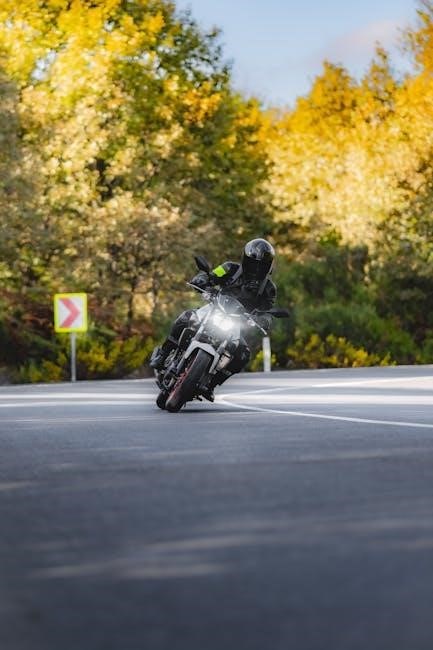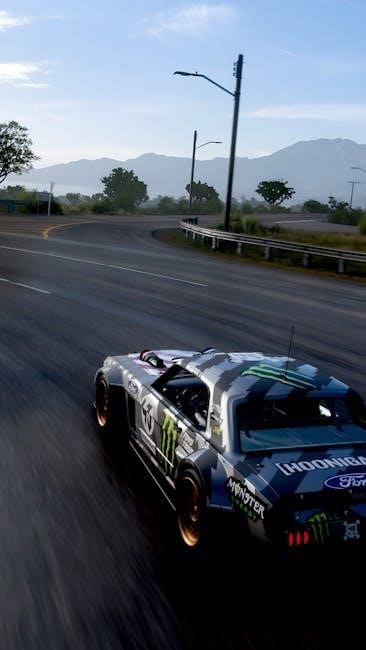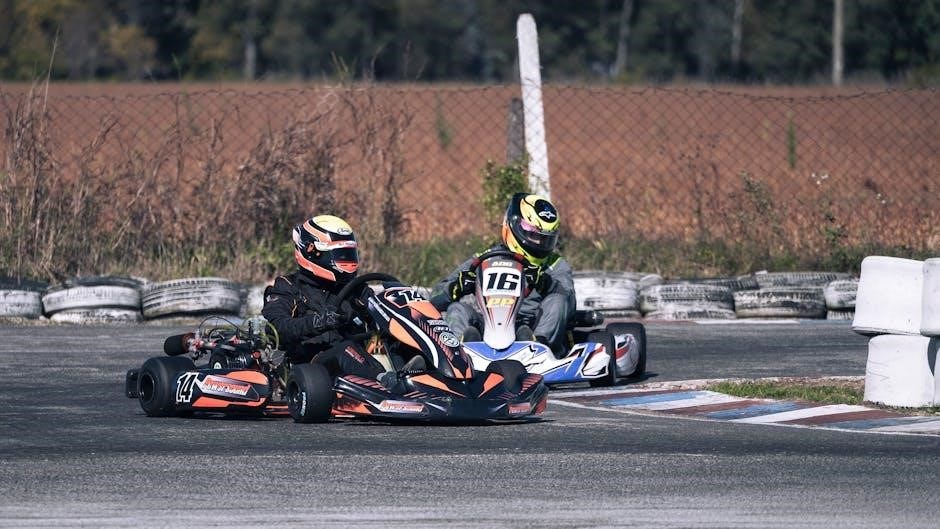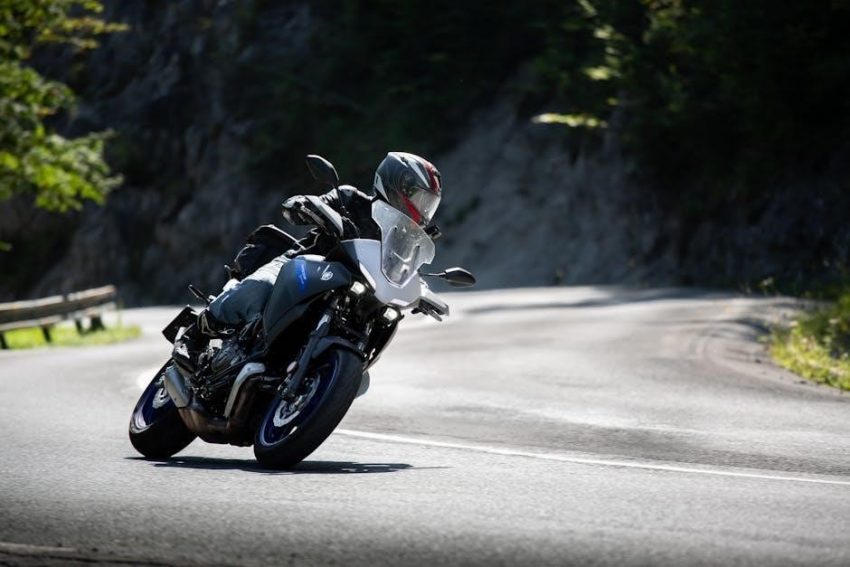How to Manually Turn the Engine on a Yamaha V-Star 1600
To manually turn the engine on your Yamaha V-Star 1600‚ start by preparing the motorcycle on a level surface and ensuring the transmission is in neutral. Locate the crankshaft bolt on the left side of the engine‚ accessible after removing the YICS cover. Attach a 19mm socket wrench securely to the bolt. Turn the wrench counterclockwise to rotate the engine‚ checking for any unusual resistance. Always follow safety guidelines‚ such as wearing protective gear and ensuring the bike is stable. After turning the engine‚ verify proper oil circulation and reassemble any removed parts before testing the motorcycle.
Preparing the Motorcycle

Before manually turning the engine on your Yamaha V-Star 1600‚ ensure the motorcycle is properly prepared. Begin by positioning the bike on a level surface to maintain stability. Engage the kickstand and ensure the transmission is in neutral gear. This prevents any accidental movement and ensures safety. Next‚ turn off the ignition and all electrical accessories to avoid unintended power draw or electrical issues. Remove the key to prevent accidental ignition. If equipped‚ disengage the kill switch and ensure the fuel valve is in the “off” position to prevent fuel flow. Wear appropriate safety gear‚ such as gloves and safety glasses‚ to protect yourself during the process. Finally‚ double-check that the area around the motorcycle is clear of tools or obstructions that could interfere with the manual turning process. Proper preparation ensures a safe and controlled environment for manually turning the engine.
Accessing the Crankshaft Bolt
To access the crankshaft bolt on your Yamaha V-Star 1600‚ locate the YICS cover on the left side of the engine. This cover is held in place by bolts and must be removed to expose the crankshaft. Use a wrench or socket set to remove the bolts securing the cover‚ then gently pull the cover away from the engine. Once the cover is removed‚ you will see the crankshaft bolt‚ which is a large‚ protruding bolt located at the end of the crankshaft. Ensure the area around the crankshaft is clean and free of debris to avoid contamination; The crankshaft bolt is designed to be turned manually‚ typically using a 19mm socket wrench‚ and is the key component for manually rotating the engine. Proper access to this bolt is essential for the next steps in the process‚ so double-check that the area is clear and the bolt is fully exposed before proceeding.
Attaching the Socket Wrench
Once the crankshaft bolt is exposed‚ attach a 19mm socket wrench to the bolt head. Ensure the socket fits snugly and aligns properly with the bolt to avoid slippage. If necessary‚ use a socket extension to gain better leverage and control. Before turning‚ double-check that the wrench is securely attached and will not slip during the process. For added stability‚ some mechanics recommend taping the socket to the bolt head to prevent accidental disengagement. Make sure the area around the wrench is clear of obstructions to allow smooth movement. Properly attaching the wrench is critical to safely and effectively manually turning the engine. If resistance is expected‚ consider using a breaker bar for increased torque. Always ensure the wrench is properly seated and aligned before applying force to avoid damaging the bolt or surrounding components.
Safety Precautions
Before manually turning the engine‚ ensure all safety precautions are in place to avoid accidents or injuries. Wear protective gear‚ including gloves and safety glasses‚ to protect yourself from potential debris or tool slippage. Ensure the motorcycle is on a level surface and securely supported by a sturdy stand or jack to prevent tipping. Disconnect the ignition or battery to avoid accidental engine start-up while manually turning the crankshaft. Be cautious of moving parts‚ as the engine’s rotational force can cause unexpected movement. Never leave tools unattended near the engine‚ and ensure the area is clear of flammable materials. If the engine has not been turned in a long time‚ check for any signs of damage or wear on components like the starter motor or spark plugs. Always refer to your service manual for specific safety warnings and follow recommended procedures to minimize risks. Failure to observe these precautions could result in severe injury or damage to the motorcycle.
Manually Turning the Engine
To manually turn the engine on your Yamaha V-Star 1600‚ begin by ensuring the motorcycle is on a level surface and supported by a sturdy stand for stability. Disconnect the ignition or battery to prevent accidental engine start-up. Locate the crankshaft bolt on the left side of the engine‚ which may require removing the YICS cover. Attach a 19mm socket wrench to the bolt and turn it counterclockwise to rotate the engine. Be cautious of any resistance or unusual noises‚ as these could indicate potential issues. Avoid over-turning‚ as manual operation lacks the normal lubrication of a running engine. After several rotations‚ check the oil circulation by removing the spark plugs and cranking the engine to ensure oil reaches the cylinders. Consult the service manual for specific guidance and always prioritize safety to prevent damage or injury.
Checking Engine Oil
After manually turning the engine‚ it’s crucial to check the engine oil to ensure proper lubrication and prevent potential damage. Locate the oil drain plug at the bottom of the engine and place a drain pan underneath. Remove the plug using a socket wrench‚ allowing the oil to flow into the pan. Once the flow slows‚ replace the plug securely. Next‚ use the dipstick to check the oil level‚ ensuring it’s within the recommended range specified in your Yamaha V-Star 1600 service manual. Add oil if necessary‚ using the type recommended by Yamaha. Start the engine briefly to circulate the oil‚ then turn it off and recheck the dipstick to confirm the level. Proper oil circulation is essential‚ especially after manual engine rotation‚ to prevent internal components from seizing due to lack of lubrication. Always refer to your service manual for specific oil capacity and type recommendations to maintain your motorcycle’s health.
Handling the Starter Motor

When manually turning the engine‚ it’s important to handle the starter motor with care to avoid unintended engagement. Ensure the ignition is turned off and the motorcycle is in neutral to prevent the starter from activating while you’re working. If the starter motor is faulty or malfunctioning‚ it may not turn the engine over properly‚ leading to slow cranking or no rotation at all. To address this‚ inspect the battery and starter connections for cleanliness and tightness‚ as poor connections can prevent the starter from functioning correctly. If issues persist‚ consider testing the battery’s charge and load capacity‚ as a weak battery may not provide enough power to turn the engine. Additionally‚ check the starter relay and solenoid for proper operation‚ as these components are critical to the starting process. Always refer to your Yamaha V-Star 1600 service manual for specific instructions on diagnosing and repairing starter motor-related issues to ensure safe and effective troubleshooting.

Reassembly and Testing

After manually turning the engine‚ carefully reassemble any components you removed‚ such as the YICS cover on the left side of the engine. Ensure all bolts and fasteners are tightened to the manufacturer’s specified torque values to avoid damage or leaks. Once reassembled‚ check the engine oil level and top it off if necessary to ensure proper lubrication. Start the motorcycle and allow it to idle for a few minutes to circulate the oil throughout the engine. Listen for any unusual noises or vibrations‚ which could indicate improper assembly or underlying issues. Test the motorcycle by taking it for a short ride‚ monitoring performance and ensuring smooth operation. If you notice any problems‚ such as misfires or lack of power‚ refer to your service manual for troubleshooting guidance. Always wear protective gear during testing and ensure the motorcycle is functioning safely before riding.

Final Checks

Once you’ve completed the manual engine turning process and reassembled your Yamaha V-Star 1600‚ perform a series of final checks to ensure everything is in proper working order. Begin by visually inspecting all connections‚ bolts‚ and components for tightness and integrity. Check the engine oil level and ensure there are no leaks around the crankshaft or other areas you worked on. Start the motorcycle and let it idle for a few minutes to confirm smooth operation and proper oil circulation. Test the throttle response‚ brakes‚ and transmission to ensure all systems function as expected. If you notice any unusual noises‚ vibrations‚ or performance issues‚ address them immediately. Finally‚ take the motorcycle for a short test ride to verify that it runs smoothly and without any problems. Always wear protective gear during the test ride and ensure the bike is stable before moving. After confirming everything works correctly‚ your motorcycle is ready for regular use or further maintenance as needed.

